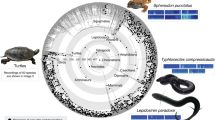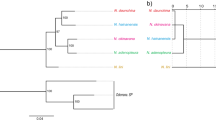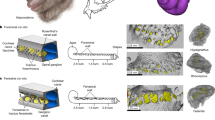Abstract
Among vertebrates, only microchiropteran bats, cetaceans and some rodents are known to produce and detect ultrasounds (frequencies greater than 20 kHz) for the purpose of communication and/or echolocation, suggesting that this capacity might be restricted to mammals1,2. Amphibians, reptiles and most birds generally have limited hearing capacity, with the ability to detect and produce sounds below ∼12 kHz. Here we report evidence of ultrasonic communication in an amphibian, the concave-eared torrent frog (Amolops tormotus) from Huangshan Hot Springs, China. Males of A. tormotus produce diverse bird-like melodic calls with pronounced frequency modulations that often contain spectral energy in the ultrasonic range3,4. To determine whether A. tormotus communicates using ultrasound to avoid masking by the wideband background noise of local fast-flowing streams, or whether the ultrasound is simply a by-product of the sound-production mechanism, we conducted acoustic playback experiments in the frogs' natural habitat. We found that the audible as well as the ultrasonic components of an A. tormotus call can evoke male vocal responses. Electrophysiological recordings from the auditory midbrain confirmed the ultrasonic hearing capacity of these frogs and that of a sympatric species facing similar environmental constraints. This extraordinary upward extension into the ultrasonic range of both the harmonic content of the advertisement calls and the frog's hearing sensitivity is likely to have co-evolved in response to the intense, predominantly low-frequency ambient noise from local streams. Because amphibians are a distinct evolutionary lineage from microchiropterans and cetaceans (which have evolved ultrasonic hearing to minimize congestion in the frequency bands used for sound communication5 and to increase hunting efficacy in darkness2), ultrasonic perception in these animals represents a new example of independent evolution.
This is a preview of subscription content, access via your institution
Access options
Subscribe to this journal
Receive 51 print issues and online access
$199.00 per year
only $3.90 per issue
Buy this article
- Purchase on Springer Link
- Instant access to full article PDF
Prices may be subject to local taxes which are calculated during checkout




Similar content being viewed by others
References
Hauser, M. D. The Evolution of Communication 124–175 (MIT Press, Cambridge, 1996)
Bradbury, J. W. & Vehrencamp, S. L. Principles of Animal Communication 161–173 (Sinauer Associates, Sunderland, 1998)
Feng, A. S., Narins, P. M. & Xu, C. H. Vocal acrobatics in a Chinese frog, Amolops tormotus. Naturwissenschaften 89, 352–356 (2002)
Narins, P. M. et al. Old world frog and bird vocalizations contain prominent ultrasonic harmonics. J. Acoust. Soc. Am. 115, 910–913 (2004)
Sales, G. & Pye, D. Ultrasonic Communication by Animals 23–68 (Chapman and Hall, London, 1974)
Slabbekoorn, H. & Peet, M. Birds sing at a higher pitch in urban noise. Nature 424, 267 (2003)
Fei, L. Atlas of Amphibians of China 162–163, 188–189, 230–231 (Henan Science and Technical Publisher, Henan, 1999)
Rand, A. S. in The Evolution of the Amphibian Auditory System (eds Fritzsch, B., Ryan, M. J., Wilczynski, W., Hetherington, T. E. & Walkowiak, W.) 415–431 (John Wiley & Sons, New York, 1988)
Pumphrey, R. J. Upper limit of frequency for human hearing. Nature 166, 571 (1950)
Corso, J. F. Bone-conduction thresholds for sonic and ultrasonic frequencies. J. Acoust. Soc. Am. 35, 1738–1743 (1963)
Dieroof, H. G. & Ertel, H. Some thoughts on the perception of ultrasonics by man. Arch. Oto-Rhino-Laryn. 209, 277–290 (1975)
Hosoi, H., Imaizumi, S., Sakaguchi, T., Tonoike, M. & Murata, K. Activation of the auditory cortex by ultrasound. Lancet 351, 496–497 (1998)
Imaizumi, S. et al. Ultrasound activates the auditory cortex of profoundly deaf subjects. Neuroreport 12, 583–586 (2001)
Feng, A. S., Narins, P. M. & Capranica, R. R. Three populations of primary auditory fibers in the bullfrog (Rana catesbeiana): their peripheral origins and frequency sensitivities. J. Comp. Physiol. 100, 221–229 (1975)
Lewis, E. R. & Narins, P. M. in Comparative Hearing: Fish and Amphibians (eds Fay, R. R. & Popper, A. N.) 218–268 (Springer, New York, 1999)
Loftus-Hills, J. J. & Johnstone, B. M. Auditory function, communication, and the brain-evoked response in anuran amphibians. J. Acoust. Soc. Am. 47, 1131–1138 (1970)
Manley, G. A. The middle ear of the tokay gecko. J. Comp. Physiol. 81, 239–250 (1972)
Jørgensen, M. B. & Kanneworff, M. Middle ear transmission in the grass frog, Rana temporaria. J. Comp. Physiol. 182, 59–64 (1998)
Mason, M. J. & Narins, P. M. Vibrometric studies of the middle ear of the bullfrog Rana catesbeiana I. The extrastapes. J. Exp. Biol. 205, 3153–3165 (2002)
Mason, M. J. & Narins, P. M. Vibrometric studies of the middle ear of the bullfrog Rana catesbeiana II. The operculum. J. Exp. Biol. 205, 3167–3176 (2002)
Anson, M., Pinder, A. C., Keating, M. J. & Chung, S. H. Acoustic vibration of the amphibian eardrum studied by white noise analysis and holographic interferometry. J. Acoust. Soc. Am. 78, 916–923 (1985)
Purgue, A. P. Tympanic sound radiation in the bullfrog Rana catesbeiana. J. Comp. Physiol. 181, 438–445 (1997)
Chen, B.-H. The Amphibian and Reptilian Fauna of Anhui (Anhui Publishing House of Science and Technology, Heifei (Anhui), 1991)
Siemers, B. M. & Schnitzler, H.-U. Echolocation signals reflect niche differentiation in five sympatric congeneric bat species. Nature 429, 657–661 (2004)
Ohr, E. A. Tricaine methanesulfonate-I: pH and its effects on anesthetic potency. Comp. Biochem. Physiol. C 54, 13–17 (1976)
Kinsler, L. E. & Frey, A. R. Fundamentals of Acoustics 186–200 (John Wiley, New York, 1962)
Acknowledgements
We wish to thank X. Yu and J. Gao for their assistance in the field, E. Ko and B.-P. Umunna for analysis of the sound files, C. Park and J. Stelle for 3D reconstruction of the frog's ear, A. Schaub and B. Siemers for technical assistance with the recording and playback systems, L. Fei for identification of frog species, and M. Hauser, J. Simmons, T. Smith and R. Suthers for comments on the manuscript. This work was supported by grants from the National Institute on Deafness and Other Communication Disorders (to A.S.F. and P.M.N.), a grant from the National Science Foundation to A.S.F., a grant from the State Key Basic Research and Development Plan (China) to C.-H.X., and a grant from the National Natural Sciences Foundation (China) to J.-X.S. Author Contributions A.S.F., P.M.N. and J.-X.S. were responsible for project planning. All authors (except Q.Q.) conducted the behavioural experiments, and A.S.F. and P.M.N. analysed the behavioural data. A.S.F., P.M.N., J.-X.S., Q.Q. and Z.-L.Y. conducted the electrophysiological experiments, and Q.Q. and Z.-L.Y. analysed the physiological data. A.S.F. performed the anatomical experiments and analysed the anatomical data.
Author information
Authors and Affiliations
Corresponding author
Ethics declarations
Competing interests
Reprints and permissions information is available at npg.nature.com/reprintsandpermissions. The authors declare no competing financial interests.
Rights and permissions
About this article
Cite this article
Feng, A., Narins, P., Xu, CH. et al. Ultrasonic communication in frogs. Nature 440, 333–336 (2006). https://doi.org/10.1038/nature04416
Received:
Accepted:
Published:
Issue Date:
DOI: https://doi.org/10.1038/nature04416
This article is cited by
-
Ultrasonic distress calls and associated defensive behaviors in Neotropical frogs
acta ethologica (2024)
-
Frequency jumps and subharmonic components in calls of female Odorrana tormota differentially affect the vocal behaviors of male frogs
Frontiers in Zoology (2023)
-
Variations in cochlea shape reveal different evolutionary adaptations in primates and rodents
Scientific Reports (2023)
-
DPOAEs and tympanal membrane vibrations reveal adaptations of the sexually dimorphic ear of the concave-eared torrent frog, Odorrana tormota
Journal of Comparative Physiology A (2023)
-
Neuroethology of sound localization in anurans
Journal of Comparative Physiology A (2023)
Comments
By submitting a comment you agree to abide by our Terms and Community Guidelines. If you find something abusive or that does not comply with our terms or guidelines please flag it as inappropriate.



